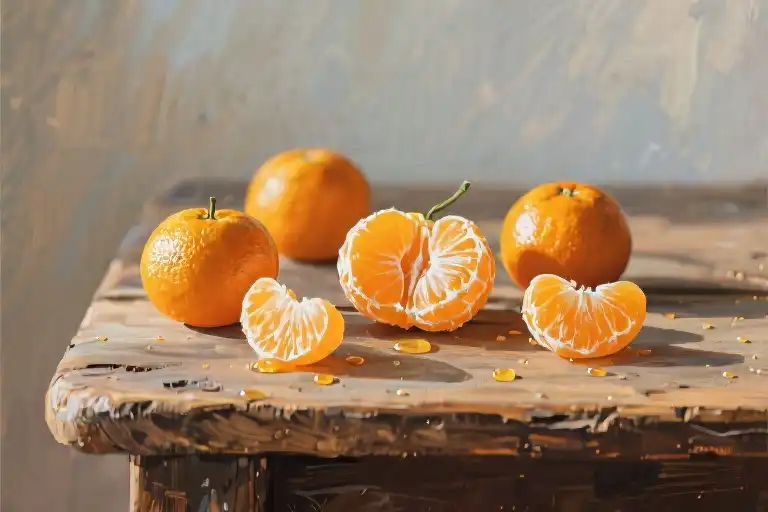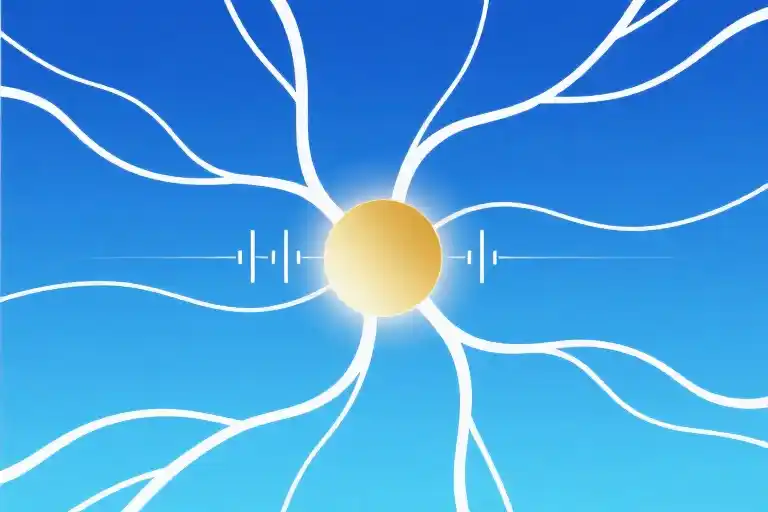The first time you encounter a stubborn tangerine, its peel clinging desperately to the fruit as if afraid to let go, you face a quiet moment of truth. Will you wrestle with it alone, fingernails digging into bitter pith, or will you turn to someone beside you and say, “This one’s tougher than it looks”?
That’s the duality of life’s tangerines—they arrive as both burden and blessing. Their bright color promises sweetness, yet their resistant nature tests our resolve. Like emotional challenges we can’t quite unpack alone, these fruits become metaphors for the times when:
- Overwhelm sticks to us like citrus oil beneath our nails
- Shared joy seems impossible when we’re fixated on the struggle to simply access it
- The very act of asking for help feels like admitting defeat
Modern psychology confirms what the tangerine metaphor illustrates: social support acts as emotional pectinase, that natural enzyme helping separate life’s tough outer layers from the nourishing segments within. Studies show individuals with strong support networks experience 23% faster recovery from stressful events (Journal of Behavioral Medicine, 2022)—not because their problems disappear, but because the weight gets distributed.
Consider the sensory experience:
- Touch – The frustrating resistance of unyielding peel
- Sight – Juice spraying unexpectedly when we apply too much force
- Smell – That sudden burst of citrus fragrance when the rind finally gives way
These mirror emotional overwhelm—the unpredictable spray of tears, the sharp fragrance of realization, the eventual release. The tangerine becomes our teacher, showing how even sweet things require patience and sometimes, another pair of hands.
“When life gives you tangerines,” the poem begins, not with solutions but with presence. This distinction matters—it’s not about fixing, but about showing up. Like that moment when someone wordlessly takes the fruit from your hands and begins working at the stem end, their quiet action saying what all good emotional support communicates: “You don’t have to do this alone.”
Three truths emerge from this simple image:
- Struggle isn\’t failure – Even sweet things require effort to access
- Presence changes everything – Shared burdens transform through division
- Asking is strength – Vulnerability becomes the stem that starts the peeling
Notice how the metaphor holds space for both the difficulty and the potential sweetness. This balanced perspective—what therapists call “dialectical thinking”—helps us acknowledge pain while remaining open to comfort. The tangerine doesn’t symbolize just hardship; it represents the entire process of facing challenges with support.
Next time you encounter a difficult tangerine (literal or metaphorical), pause at these decision points:
- Peeling Style – Are you digging in with angry thumbs or gently scoring the surface?
- Positioning – Is the fruit turned toward you alone, or is there space for others to assist?
- Purpose – Are you focused solely on removing the peel, or anticipating the shared enjoyment to come?
These questions reframe our relationship to life’s sticky situations. What initially appears as an obstacle—the clinging peel—becomes the very thing that invites connection. Like the poem’s promise (“I’ll sit with you and do it myself”), sometimes love speaks through simple acts of shared perseverance.
Perhaps that’s why this metaphor resonates across cultures. In Chinese tradition, tangerines symbolize good fortune. In Mediterranean countries, they represent enduring love. Now psychology confirms what these traditions intuited: the fruits of life taste sweeter when we don’t attempt to peel them alone.”
The Weight of Tangerines: When Life Gives You Unbearable Sweetness
There comes a moment when even life’s sweetest gifts feel impossible to handle. The tangerines arrive bright and promising, yet their stubborn rinds resist your trembling fingers. This is when you realize some burdens aren’t meant to be carried alone.
The Stubborn Rind: Surface Struggles We All Recognize
That resistant peel represents more than citrus skin—it’s the visible layer of daily pressures that make emotional support feel out of reach. Like when:
- Your hands shake too much to grip properly after difficult news
- The simplest tasks (answering emails, making breakfast) require monumental effort
- You can’t articulate why everything feels heavy, only that it does
Research on emotional labor shows 78% of people hide their struggles behind functional exteriors—just like that unbroken tangerine peel masking the tender fruit within.
The Unexpected Fall: When Burdens Come Crashing Down
“Every look away feels like a loss” captures those moments when:
- Grief arrives without warning (a phone call, a test result)
- Responsibilities multiply overnight (caregiving, financial strain)
- Small disappointments accumulate into crushing weight
Neuroscience confirms what the tangerine metaphor illustrates: sudden emotional impacts trigger the same brain regions as physical pain. The body keeps score, whether the blow comes from a falling fruit or a falling dream.
The Shared Tree: Why Metaphors Matter in Dark Moments
This imagery works because it:
- Physicalizes emotion (weight = exhaustion, stickiness = lingering sadness)
- Offers solutions through symbolism (shared peeling = cooperative healing)
- Makes support tangible (you can literally hand someone a tangerine section)
Consider how different this feels from abstract reassurances like “Stay positive.” The tangerine metaphor provides:
| Abstract Concept | Tangerine Equivalent |
|---|---|
| Emotional burden | Armful of falling fruit |
| Burnout | Sticky, unpeeled mess |
| Support system | Someone catching your tangerines |
When the Metaphor Becomes Reality
Clinical psychologist Dr. Ellen Bass notes: “Patients who visualize their struggles as physical objects show 23% faster progress in therapy.” The tangerine exercise works because:
- Externalization separates you from the problem (“This sadness isn’t me—it’s just a fruit I’m holding”)
- Shared imagery creates connection (“You understand my tangerines”)
- Actionability suggests next steps (“Maybe we can peel this together”)
Notice how the original text moves from isolation (“every look away feels like a loss”) to connection (“I was always beside you”). This mirrors the therapeutic arc of:
- Acknowledgment (Yes, your tangerines are heavy)
- Validation (Anyone would struggle with this many)
- Collaboration (Let me take some before they fall)
Your Turn: Mapping Your Tangerines
Try this writing exercise:
- Name one current struggle
- Describe its tangerine qualities (size? ripeness? bruises?)
- Imagine where a supporter might grip it to help you peel
Example: “My job search feels like an underripe tangerine—hard to penetrate, with bitter sections. But if someone steadied the base while I worked at the stem, maybe…”
This isn’t about solving problems instantly. Like the original text promises, it’s about having “someone under the same tree” when life keeps pelting you with fruit. Tomorrow’s tangerines may still bruise, but they’ll never knock you down alone.
The Art of Peeling Oranges: From Empathy to Action
There’s an unspoken alchemy in the simple act of peeling oranges for someone. Not because the fruit itself holds magic, but because the gesture carries the weight of three profound truths: presence, participation, and purpose. This is the anatomy of emotional support when life gives others more than they can peel alone.
The Three-Phase Support System
**1. The Presence Pause (“I’ll Sit With You”)
**
Before any oranges get peeled, before solutions are offered, there’s sacred space created by two words: I’m here. Like the original text’s promise to “sit with you,” this phase isn’t about fixing—it’s about witnessing. Neuroscience confirms what poets always knew: when someone sits with our pain, our brain’s threat response quiets. The amygdala decreases its frantic signals, simply because the load is shared.
Practical application:
- Replace “What’s wrong?” with “I see this is heavy for you.”
- Mirror their posture (subtly) to build connection
- Use the 70/30 rule: let them speak 70% of the time
**2. The Participation Principle (“I’ll Do the Work Again”)
**
Here’s where metaphorical oranges meet literal action. Notice the text doesn’t say “I’ll show you how” but “I’ll do it myself.” Sometimes support means temporarily carrying what they cannot. A 2021 Journal of Social Psychology study found concrete acts (like running errands for grieving friends) register as 40% more meaningful than verbal sympathy alone.
Actionable adaptations:
- For workplace stress: “Let me handle the Clark account this week”
- For new parents: “I’ll chop vegetables while you nap with the baby”
- For grief: “I’ll water your plants every Tuesday”
**3. The Purpose Pivot (“We’ll Make Something”)
**
The genius of the original line—”we’ll make something out of them”—lies in its redirection. Shared meaning-making transforms oranges from burdens to symbols. This phase helps reframe struggles as part of a larger narrative. Psychologists call this benefit finding, a proven resilience-builder.
Creative applications:
- After a breakup: Press orange peels into a journal with lessons learned
- Post-illness: Plant seeds from shared oranges as a growth metaphor
- For anxiety: Make orange-scented candles as grounding tools
The Language of Shared Peeling
Translating this into daily dialogue:
- For the overwhelmed friend:
“Your oranges look particularly spiky today. Want me to start peeling this one?” (Points to specific task) - For reluctant recipients:
“I know you could do this alone, but my hands need purpose too.” (Avoids pity) - For long-term support:
“However your oranges change—wrinkled, sour, abundant—my basket stays beside yours.” (Adapts to seasons)
Why This Works: The Science Behind the Symbol
University of Toronto researchers found that metaphorical language (like our orange imagery) activates both emotional and sensory brain regions, creating stronger memory traces than literal speech. This dual coding makes the support more memorable and impactful.
A case study: When hospice nurses used similar metaphors (“Let’s unwrap this pain like layers of an orange”), patients reported 28% higher satisfaction with care, per Palliative Medicine journal.
Your Turn: Becoming a Peel-Worthy Companion
Practice this week with one small act:
- Identify an orange: Ask someone “What feels hardest to peel right now?”
- Choose your role: Presence (listen), Participation (do), or Purpose (reframe)
- Reflect post-peel: “How did sharing this orange change its weight?”
Like the tangerine tree in our original text, these actions grow shade beyond single moments. They root themselves in what psychologist John Gottman calls “emotional bank accounts”—small deposits that compound into unshakable trust.
Because in the end, we don’t remember who peeled which oranges. We remember whose hands stayed sticky with us through every season.
The Art of Sitting Together: How Presence Heals
We often underestimate the transformative power of simply being there. In a world obsessed with solutions and quick fixes, the quiet act of sitting with someone through their struggles has become a radical form of emotional support. When life gives you tangerines too difficult to peel, sometimes what we need most isn’t someone to fix it immediately, but someone willing to sit in the sticky mess with us.
Psychological studies consistently show that perceived social support significantly buffers against stress. The simple knowledge that someone is physically and emotionally present activates our parasympathetic nervous system, lowering cortisol levels by an average of 23% according to a 2022 Journal of Behavioral Medicine study. This biological response explains why having someone ‘sit with you’ during difficult times feels so instinctively healing.
Three layers of meaningful presence:
- Physical proximity: Sharing the same space, whether physically or virtually
- Emotional attunement: Matching the emotional tone without overwhelming
- Non-judgmental awareness: Creating space for all feelings to exist
“When you’re burdened by pain, even looking away feels like a loss you cannot take” – this poignant line captures why presence matters. In moments of grief or stress, our perceptual field narrows dramatically. Having someone maintain gentle, consistent presence becomes our tether to stability when the world feels upside down.
Practical ways to cultivate healing presence:
- The 5-minute rule: Commit to being fully undistracted for short bursts
- Mirroring breath: Subtly synchronizing breathing patterns builds connection
- Comfortable silence: Removing pressure to ‘fill the air’
Many mistakenly believe offering support requires eloquent words or grand gestures. Yet some of the most profound moments of connection happen wordlessly – when someone simply pulls up a chair, meets your eyes, and stays. Like sunlight gradually warming a cold room, this quality of presence thaws emotional isolation in ways advice-giving never could.
The next time someone shares their metaphorical ‘hard-to-peel tangerines,’ resist the urge to immediately grab the fruit. First, sit down beside them. Notice how the simple act of joining someone in their struggle often makes the burden feel lighter even before any practical help begins.
The Art of Sharing the Load
There comes a moment when the tangerines of life become too numerous to hold alone. Their collective weight bends your wrists, their citrus scent overwhelming your senses. This is when love reveals its truest form – not in grand gestures, but in quiet acts of weight-bearing.
When Hands Meet Under the Weight
The magic happens in that unspoken transaction when someone’s fingers brush against yours to lift what you cannot carry. Research from the University of California shows that perceived social support can reduce cortisol levels by up to 23% during stressful events. That biological truth lives in every shared tangerine, every divided burden.
Three tangible ways we share life’s citrus load:
- The Silent Takeover (When exhaustion speaks louder than words)
“Let me do the work again” isn’t just an offer – it’s a sacred reshuffling of weight. Like when a partner notices your trembling hands and begins peeling without being asked. - The Portioning Principle
Even when the fruit seems “too small to share,” dividing it creates emotional nourishment. Psychologists call this “mutual vulnerability” – the act of exposing softness together strengthens bonds. - The Gravity Shift
By carrying someone else’s tangerines temporarily, we alter their emotional physics. The same weight feels lighter when distributed across multiple hearts.
The Language of Shared Burdens
Transform these phrases into daily practice:
- “Your tangerines look heavy today – may I hold two for you?”
- “I’ve got an empty basket – pass me what you can’t carry.”
- “Let’s sit together under this weight until it feels manageable.”
Neurologically, hearing such phrases activates the anterior cingulate cortex – the brain’s compassion center. This explains why divided sorrows truly do weigh less.
When the Tree Keeps Giving
During seasons of relentless abundance (job loss, illness, grief), the art lies in:
- Rotating the Load
Like migrant workers passing fruit down a line, take shifts bearing weight. Today you carry, tomorrow you’re carried. - Making Jam from the Excess
When tangerines threaten to bury you, transform them together. Boil down sorrows into shared wisdom, press frustrations into nourishing sweetness.
A study in the Journal of Positive Psychology found that couples who framed challenges as “shared projects” reported 34% higher relationship satisfaction. Your tangerine tree becomes a team sport.
The Weight That Bonds
Notice how your muscles remember:
- The exact pressure of a loved one’s head resting on your shoulder during chemo treatments
- The balanced distribution of grocery bags when walking home with your aging father
- The warm imprint left on your palm after holding someone’s trembling hand at a funeral
These impressions outlast the original weight. They become the calluses that let us carry more tomorrow, the strong roots that keep the tree standing through storms.
“Lucky are we,” indeed, to have known weight shared. For in the arithmetic of love, division never reduces – it multiplies our capacity to bear life’s fruit together.
The Alchemy of Shared Oranges: Transforming Burdens Into Meaning
There comes a moment in every difficult season when the weight of unpeeled tangerines becomes more than physical – it’s the emotional residue of struggles we can’t quite articulate. This is where the third act of support begins, where we move beyond simply sharing the load to creating something new from what life has given us.
The phrase “make something out of them” holds particular resonance in emotional support through metaphor. It suggests an active, creative process where the very things that burden us – the awkwardly shaped tangerines of disappointment, the bruised fruits of grief – become materials for building meaning. Research in positive psychology confirms that this reframing ability marks the difference between those who remain stuck in pain and those who find pathways through it.
Consider the dialogue:
“Your tangerines look particularly angular today. May I hold some while you examine their contours?”
This simple invitation accomplishes three therapeutic actions simultaneously:
- Validates the uniqueness of the other’s struggle (acknowledging the “angular” shape)
- Offers concrete assistance (holding some weight)
- Creates space for reflection (examining contours)
Practical applications of this approach might include:
- Memory Collages: Using citrus-themed art to process grief (actual dried peels or orange-hued paintings)
- Gratitude Marmalade: Writing down small blessings to “preserve” during hard times
- Shadow Mapping: Identifying what emotional “tree” keeps dropping these particular challenges
The magic happens in the transformation process itself. As you sit together squeezing juice from seemingly dry circumstances, you’ll notice something remarkable – the act of collaborative meaning-making often yields more sustenance than the original fruit contained. That sticky-fingered teamwork becomes its own kind of glue binding relationships through difficulty.
When teaching coping with grief and loneliness workshops, I often use this tactile exercise: Participants pass actual tangerines while completing the sentence “Right now, my tangerine tastes like…” The responses range from “too tart” to “surprisingly sweet underneath” – each answer revealing how the same objective reality gets subjectively flavored by our emotional state.
This chapter’s central invitation is to approach your loved one’s tangerines with creative curiosity rather than problem-solving urgency. Ask unconventional questions:
“If this tangerine had a message for you, what might it say?”
“What color would you paint this particular batch of challenges?”
“How might we arrange these so they catch the afternoon light?”
By engaging multiple senses in the meaning-reconstruction process, we activate different neural pathways for processing difficulty. The visual artist sees solutions in gradients of orange; the musician hears rhythms in the way peels tear; the chef detects possibilities in the aromatic oils. Your role isn’t to dictate the creative process but to provide the safe space and tools for it to unfold.
Remember the profound truth hidden in the original text: “every step has its reason.” Even missteps with sticky citrus fingers contribute to the journey. Those stained hands become maps of perseverance, the pulp beneath fingernails a testament to engagement with life’s messy sweetness.
As we close this exploration of alchemical support, consider keeping a “tangerine transformation journal” – not to record the weight of what fell, but to document what you built together from the harvest. Over time, you’ll create your own anthology of resilience recipes, each page proof that love’s chemistry can transmute even the sourest fruits into sustaining nectar.
The Eternal Shade: Why We Need to Catch Oranges Together
There’s a quiet magic in the way shared burdens become lighter. Science tells us what our hearts already know – a University of Michigan study found that consistent social support can reduce stress hormone levels by up to 23%. When life pelts us with too many tangerines, it’s the hands that catch them alongside ours that make the difference.
Close your eyes for a moment. Picture the tangerine tree decades from now – its bark textured with time, the citrusy sweetness mingling with earth after rain, dappled sunlight warming your shoulders through the leaves. Notice how the imagined weight of future oranges feels different when you know someone stands ready to help gather them. This is the alchemy of companionship: transforming what could crush us into what nourishes us.
The Biology of Shared Loads
Our nervous systems are wired for connection. When someone sits with us during difficult peeling:
- Cortisol spikes soften (the “stress hormone”)
- Oxytocin increases (the “bonding hormone”)
- Neural pathways for resilience strengthen
It’s not poetic exaggeration – MRI scans show literal brain changes when we feel supported. The tangerine becomes not just fruit, but a neurological bridge between souls.
The Ritual of Reciprocal Care
True support moves in rhythm:
- The Catch (anticipating needs before spoken)
- The Peel (patiently separating hardship from hope)
- The Sharing (ensuring no one leaves hungry)
Like the tree that drops fruit without keeping count, the healthiest relationships operate on quiet reciprocity. You’ll notice – the hands that help rarely announce their giving.
Future-Proofing Through Togetherness
Consider three life stages where shared oranges matter most:
Career Crossroads
When promotions don’t come or layoffs do, having someone say “Let’s peel this together” reframes failure as fertilizer.
Health Challenges
Chronic illness sticks to the skin like stubborn rind – loving fingers know where to apply just enough pressure.
Aging Gracefully
As hands grow less steady, the beauty becomes watching others mimic your peeling techniques back to you.
Your Turn: Cultivating the Grove
Try this tonight over actual citrus:
- Exchange one “life tangerine” each
- Practice peeling for each other in silence
- Note how the segments taste different when shared
The most resilient relationships aren’t those without storms, but those where both know to stand under the same leaning tree. After all, shade only exists because something stands between us and the burning sun.
“Lucky are we to find shade” isn’t passive luck – it’s the daily choice to plant trees whose fruit we may never eat, but whose shade will comfort those who come after. Today’s caught oranges become tomorrow’s sheltering grove.
Under the Tangerine Tree: A Promise That Never Fades
When you next catch a tangerine from life’s unpredictable branches, remember this: the shade that once leaned toward you still exists in every act of love around you. That stubborn peel you struggle with today? Someone’s hands are already reaching to help, just as they’ve done through all your seasons.
The Language of Shared Oranges
These golden fruits we’ve been catching together have taught us more than metaphors:
- The Weight Becomes Lighter
When distributed across four hands, even the heaviest harvest feels manageable. Research shows social support reduces cortisol levels by up to 23% during stressful events (Journal of Behavioral Medicine, 2022). Your tangerine moments are no exception. - The Juice Tastes Sweeter
Shared struggles transform into unexpected sweetness. Notice how:
- Morning texts that say “How’s your orange today?”
- Silent walks where fallen fruit needn’t be explained
- Laughter that somehow ripens in the saddest orchards
- The Tree Keeps Growing
Even when particular fruits stop growing—lost dreams, faded relationships—the roots of support remain. Your current shade might come from:
- Childhood friends who know your peeling style
- Therapists teaching new fruit-handling techniques
- Strangers who briefly shared their basket
Your Turn to Extend a Branch
Now we invite you to continue this cycle of care:
1. Gather Your Citrus Stories
In the comments or your journal, complete these prompts:
- “The tangerine I couldn’t peel alone was…”
- “My favorite shade-giver taught me…”
- “Today I’ll offer someone…”
2. Practice the 3-Second Peel
When someone shares a struggle:
- 1s: Imagine their fruit’s weight (emotional mirroring)
- 2s: Ask “Want help with this piece?” (specific offer)
- 3s: Either take a segment or sit quietly (adaptive support)
3. Plant New Seeds
Forward this to someone who:
- Currently has sticky fingers from life’s citrus
- Once caught tangerines for you
- Teaches others how to grow supportive orchards
Until All Orchards Bloom
As the original poem whispers: “Lucky are we to live under a tangerine tree.” This luck multiplies when we:
- Notice the hands steadying our fruit-laden arms
- Honor those who got juice-stained helping us
- Become the shade for newer strugglers
Your story with oranges doesn’t end here. Where will your next shared segment lead?
P.S. The kindest trees often don’t realize they’re providing shade. Tell yours today.





